Layout and features
A quick word of two about nForce4 SLI Intel Edition for those yet unacquainted with it. It's NVIDIA's first foray into LGA775 and, for that matter, lucrative Intel country, and it's gone for the jugular by launching an SLI-capable chipset right off the bat. Most of the features have been ported right on over from the established AMD nForce4 SLI, although NVIDIA has had to be a little more creative when architecting it for LGA775. As you'll see if you look further on down this page and contrary to the single chip for AMD's S939 CPUs, NVIDIA's used discrete north and southbridges. That's been necessary as the Pentium 4 requires an off-chip memory controller, which in nForce4 SLI I.E.'s case runs at an Intel-matching 266MHz FSB and sports an equally efficient dual-channel setup. PCI-Express support is the norm, and indeed necessary for SLI to do its dual-card magic through 2 x8 lanes, and boards will use up to 20 lanes, 16 for graphics, either allotted to one card or split between two, and 4 for peripherals.The southbridge, or MCP as NVIDIA calls it, carries 10 USB2.0 ports, offers comprehensive storage support (SATA2 support and all that it entails - NCQ, 3GB/s transfer speed), Gigabit Ethernet, and, alas, on AC'97 sound; the one chink in nForce4 SLI's armour. In short, excluding the poor onboard sound that could do with being bypassed, motherboard manufacturers won't need to pack many discrete ASICs to augment nForce4 SLI's impressive feature list. Let's now see how MSI does it with its P4N Diamond.
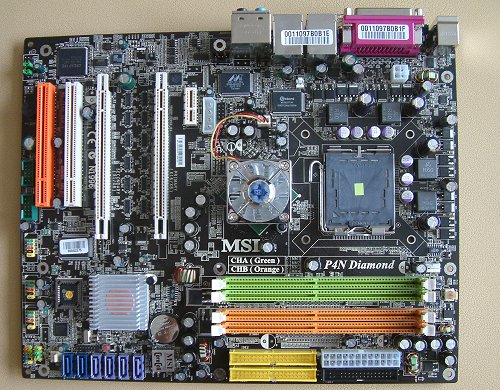
What grabs your attention first? Is it the two chips that make up nForce4 SLI Intel Edition, or is it the two longer PCI-Express slots that are designed to accommodate a couple of NVIDIA PCIe GeForce 6800-series cards in tandem. Whatever it is, get used to seeing it, as manufacturers slowly trot out their NVIDIA-based LGA775 boards in the coming weeks and months.

On first glance, there appears to be ample room around the LGA775 socket that's now home to most of Intel's current consumer-level CPUs. MSI has placed the 4-pin 12-volt connector out of the way. However, when a reference Intel heatsink is mounted, it comes dangerously close to fouling the oversized northbridge heatsink/fan combination. This close fit may preclude larger aftermarket coolers from being used. Northbridge-mounted fans are always a contentious issue. Do we really need them, considering just how annoying a 40mm fan can sound when running at, say, 6,000RPM?. SLI is all about performance, and Pentium 4s need all the frequency headroom they can manage when feeding two Ultra cards in tandem, so MSI's obviously designed the P4N Diamond to run with high FSBs in mind.
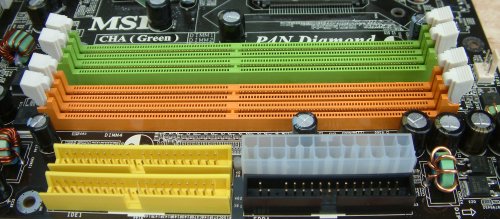
Two sets of two DIMMs offer dual-channel running. Note that if you're using just two DDR2 DIMMs, the same DIMM of each colour will need to be populated. With a 200MHz FSB Intel CPU, which is still the vast majority, NVIDIA and MSI offer dual-channel DDR2 speeds of up to 667MHz. That's far more than the processor can use, and most of it will go to waste. However, the P4N Diamond also caters for users who, somewhat inexplicably, want to run DIMMs of different sizes in each slot. The above picture's foreground shows a couple of IDE ports, a 24-pin power connector and a black floppy port. MSI's kept the second PATA port that most Intel boards dispense with, and using NVIDIA's MediaShield tech., one can combine both PATA and SATA for weird and wonderful RAID arrays.
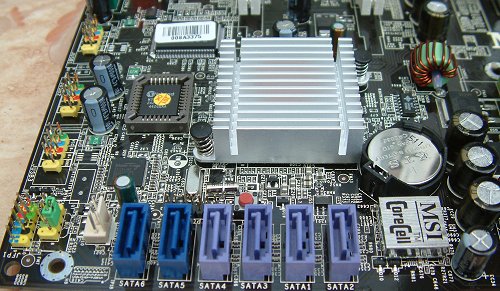
Moving on to the left of the MSI P4N Diamond, the nForce4 MCP is covered by an copper-bottomed aluminium heatsink that gets very hot when in use. Its low-profile appearance is more by necessity than choice for MSI. It won't take a rocket scientist to figure out what will cover it. MSI's CoreCell monitoring/tweaking chip does much the same job as ABIT's µGuru, that is, give users better control over voltages/speeds, thus allowing for finely-tuned overclocking. To the left are 6 SATA ports, split between 4 nForce4 SLI's (1-4) and 2 PCI-Express-riding Silicon Image Sil3132's (5-6). Both sets support SATA2 and both are configurable for RAID. Storage, in a word, is excellent on the P4N Diamond. Right above is a red button that clears CMOS in the easiest way imaginable. No more fiddling and cursing jumpers that slip through your fingers.
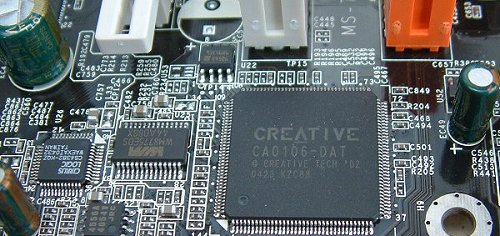
Moving on around the colour-coded motherboard-to-case pins and FireWire (VT6306 3-port ASIC) and USB headers on the side of the P4N Diamond, we see how MSI has abandoned the nForce4 SLI's mediocre onboard audio and replaced it with an altogether better solution. What you see just behind the two PCI slots is a Creative SoundBlaster Live CAO106 DSP chip that's been found on Creative's Audigy LS cards. To the left is a Wolfson 24-bit, 96KHz WM8775 ADC, and next to it a Cirrus Logic CS4382 DAC. What this all boils down to is a decent hardware-based, 8-channel, 24-bit resolution audio that's integrated right on to the motherboard. A huge step up from NVIDIA's lacklustre offering and about as good as onboard sound gets. Kudos to MSI for it.
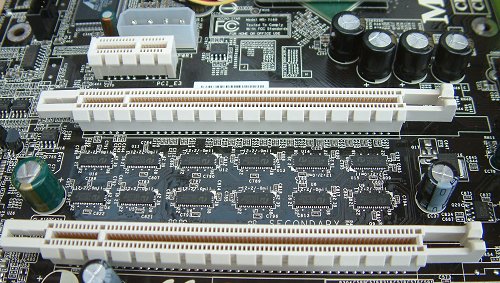
I've thus far skirted around the whole raison d'etre of this board. It's the first retail LGA775-based SLI-capable that's crossed our path. 2 PCI-Express lanes that shunt down to x8 protocol when 2 PCIe NVIDIA GeForce 6800-series cards are run in tandem. Double the cards can mean, in certain situations, almost double the frame-rate fun. You can simply run the board with any single PCI-Express card and it will function as a decent motherboard. Strap in 2 GeForce 6800 Ultras, for example, place the bridge connector on top, and the ForceWare OS graphics driver will pick the second card up. There's also no need to manually define, through the use of a reversible key, single- or dual-card use here, either. It's the first digitally switching SLI board that I've come across.

Looking at the I/O section, there's a couple of RJ45 ports that serve up dual Gigabit LAN. One's run off the nForce4 MCP's on-chip Gigabit MAC and routed out via a Marvell 88E1111 physical layer. The other is solely a Marvell affair, with the diminutive 88E8053 offering Gigabit Ethernet through the preferred PCI-Express conduit. MSI's taken the best bits out of NVIDIA's nForce4 SLI Intel Edition design and augmented it with FireWire400 support, additional SATA, another Gigabit LAN, and, most impressive of all, hardware-based 8-channel sound. The layout, considering the feature-set, is sensible, too.









